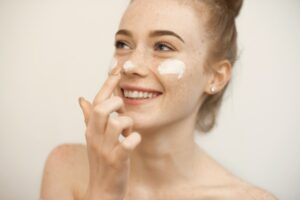If you suffer from acne, it is essential to use products that work with with your skin type and decrease inflammation.
Benzoyl Peroxide and Tretinoin are both commonly used to treat acne. Some dermatologists have warned against using both products simultaneously, claiming that it can cause skin irritation and tretinoin degradation.
In this article, we’ll go over everything you need to know about whether you can mix benzoyl peroxide and tretinoin and whether or not it’s safe to pair these two products together.
What is Benzoyl Peroxide?
Benzoyl peroxide is a popular, topical acne treatment used to help clear acne at the surface level of the skin. Benzoyl peroxide works to clear bacteria from your skin, prevent pores from clogging and help to unclog blocked pores. It’s most often found in face washes, and cleansers made for acne. Although it’s a popular and effective acne treatment, there are some side effects to be mindful of.
Side effects of benzoyl peroxide may include:
● Stinging or burning
● Itching or tingly sensation
● Dry skin
● Flaking
● Redness
● Irritation
Make sure to speak to your doctor or dermatologist about benzoyl peroxide before using it to help you avoid these potential side effects.
What is Tretinoin?
Tretinoin, also known as retinoic acid, is a common medication used to treat acne and sun-damaged skin. It can also help to reduce the appearance of fine lines, wrinkles, and dark spots on the skin. Tretinoin works to unclog pores, stimulate collagen production, reduce inflammation and minimize pigmentation. It can also be used to help treat hormonal acne.
Some of the common side effects of tretinoin include:
● Burning, stinging, or itching
● Redness
● Scaling, peeling or chapping
● Darkening or lightening of the skin
● Warmer than usual skin
Since one of the most common side effects of tretinoin is dry and irritated skin, consider using a moisturizer with tretinoin. There are many great moisturizers you can pair with tretinoin to keep your skin moisturized and free from flaking and dryness.
Does Benzoyl Peroxide Degrade Tretinoin?
One of the most common claims made by dermatologists is that benzoyl peroxide degrades tretinoin and can cause skin irritation. Many dermatologists are hesitant to prescribe using benzoyl peroxide and tretinoin at the same time because of this claim.
A clinical trial in 2010 found that mixing benzoyl peroxide and tretinoin leads to degradation, specifically when exposed to light with and without UV. The study found that 50% of the tretinoin had degraded in just 2 hours. Fortunately, this may not always be the case.
In a 2010 study that challenged this claim, researchers mixed 5% benzoyl peroxide and 0.05% tretinoin at a 1:1 ratio at 96°F. The study found that after 7 hours, there was no degradation of tretinoin strength. Researchers concluded that benzoyl peroxide did not affect the strength or effectiveness of tretinoin.
So, what does this mean for mixing these two products? If used correctly, benzoyl peroxide and tretinoin can work to reduce acne faster and more effectively than when used on their own. For the best results, it’s strongly recommended to use one in the morning and the other in the evening.
The Best Time to Use Benzoyl Peroxide
Mixing benzoyl peroxide and tretinoin can cause skin irritation and degradation under certain conditions, which is why it’s important to know exactly how to use both products together. To limit skin irritation or degradation, dermatologists recommend using a benzoyl peroxide wash in the morning and applying a tretinoin cream at night.
The Best Time to Use Tretinoin
Tretinoin is known to cause photosensitivity which means it’s essential that you protect your skin from the sunlight while using it. It’s best to apply tretinoin at night before going to bed to avoid any light degradation. This will help you achieve the best results possible while protecting your skin.
The Type of Tretinoin You Should Use
Another factor that affects the results of mixing benzoyl peroxide and tretinoin is the type of tretinoin being used. In a 2010 study, researchers examined the effectiveness of a combination regimen vs. a sequential regimen. The combination regimen consisted of a 5% benzoyl peroxide wash and tretinoin gel microsphere in the morning versus a sequential regimen of benzoyl peroxide in the morning and tretinoin in the evening. The study found that the reduction in acne lesions of the combination group was the same as the sequential group.
This study strictly examined microsphere tretinoin gel – so consult your doctor before using traditional cream with benzoyl peroxide as the combination could cause oxidation.
An Alternative Solution: Clindamycin & Tretinoin
If you’re still unsure about mixing benzoyl peroxide and tretinoin, there’s another option you can consider. An alternative solution is to try pairing clindamycin and tretinoin. Clindamycin is a topical antibiotic that works as an antibacterial and anti-inflammatory to help control acne. Unlike benzoyl peroxide, it doesn’t pose the same threat of oxidation and degradation.
Tretinoin works to cleanse out your pores and reduce clogging, while clindamycin helps to kill bacteria that cause acne and reduces acne inflammation. These two products used together are much more effective than using monotherapies.
Final Thoughts
It’s clear that there are still some conflicting studies about whether or not certain forms of tretinoin can be degraded by benzoyl peroxide, but – this doesn’t mean you can’t mix the two treatments.
Some factors can affect the results of combining these two treatments. For this reason, dermatologists suggest using a benzoyl peroxide wash in the morning and tretinoin in the evening. When used correctly, you may be able to mix benzoyl peroxide and tretinoin to achieve clear skin.
If you’re looking for a different solution, try pairing clindamycin with tretinoin. Always consult a dermatologist before using any products you’re unfamiliar with to find a solution that’s right for you.

